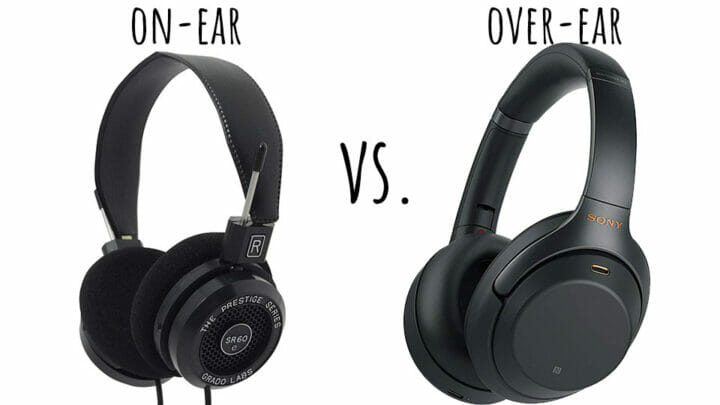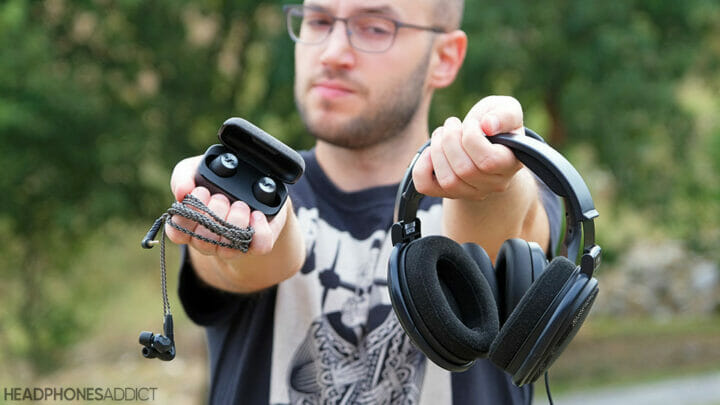I’ll give you the cheat sheet for buying headphones like an expert. Even if you’re buying headphones for the first time.
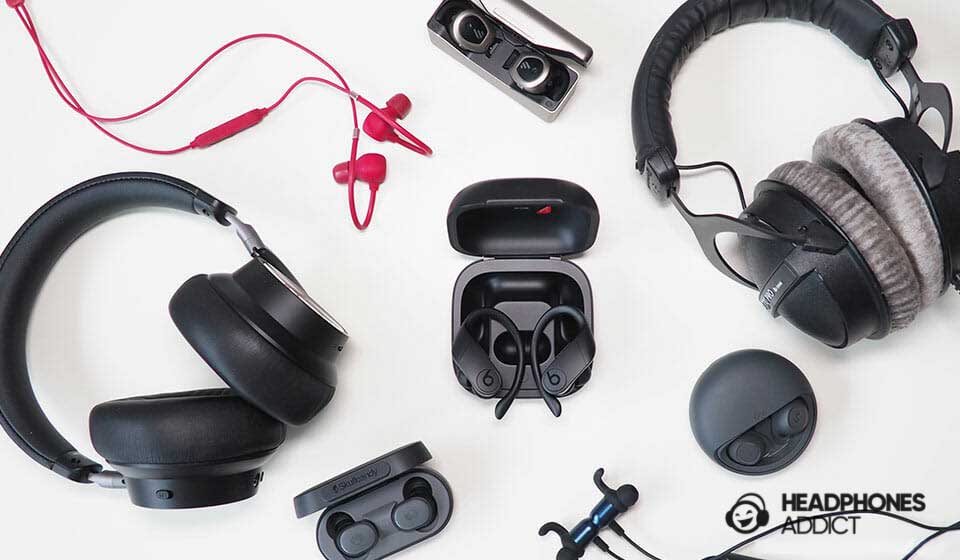
The guide will lead you by asking a few questions. Answer by following the steps, and you’ll have a good idea about what headphones are best for you.
1. What Type of Headphones Do You Want?
There are 4 types of headphone designs you can choose from:
- Over-ear headphones
- On-ear headphones
- Earbuds (in-ear headphones, earphones, in-ear monitors)
- Bone conduction headphones
Over-ear headphones
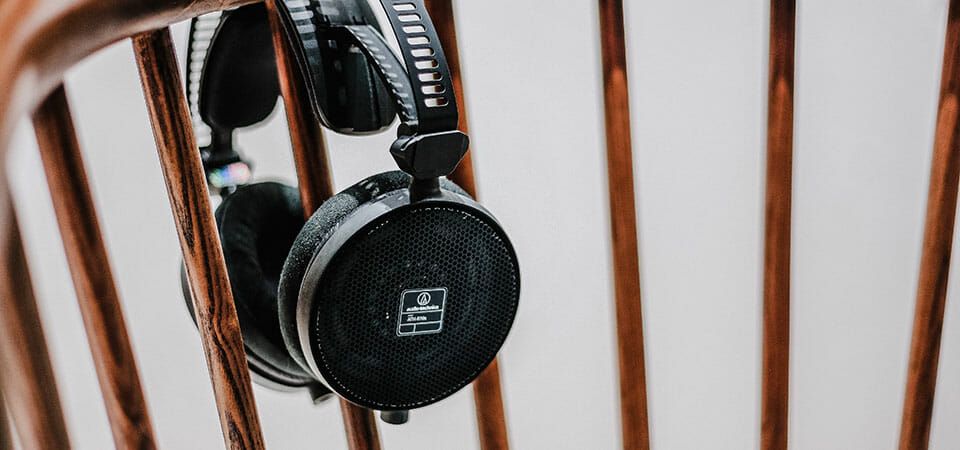
Over-ear headphones (also called circumaural) are big, bulky and cover the whole ear. They usually offer great comfort and excellent sound quality. But are not portable and are harder to store. These are most suitable for professional and home use when audio quality is a priority.
- Comfortable, cover the whole ear
- Big drivers (transducers) contribute to top-notch sound quality
- Big, bulky, not portable
- Can be heavy
- Not suitable for activity
Over-ear headphones are great for:
- Listening at home in comfort with superb sound quality
- Removing cabin noise when flying (with ANC over-ear headphones)
- Working in comfort while other people leave you alone so you can focus on the job
- Studio work, DJing and other audio production
Don’t pick over-ear headphones for:
- Working out and sports because they fall out
- Portable, on-the-go listening as they’re big and bulky
On-ear headphones

On-ear headphones (also called supra-aural) are smaller than over-ears and more portable. Thus on-ears are popular with travelers and DJs. They don’t totally cover the ear but are pushed against them.
They are portable due to their size and lightweight. Great for commuting, throwing them in a backpack, and enjoying on the move.
- More portable than over-ear, easier to pack
- Less comfortable due to smaller earcups and pads
On-ear headphones are great for:
- Portable listening thanks to a smaller design
- Medium-intensity activity because they are stable up to a certain point
Don’t pick on-ear headphones for:
- Long listening and gaming because they can become uncomfortable after some time
- The best sound quality because they have smaller drivers compared to over-ears
Earbuds (in-ear headphones, earphones, in-ear monitors)
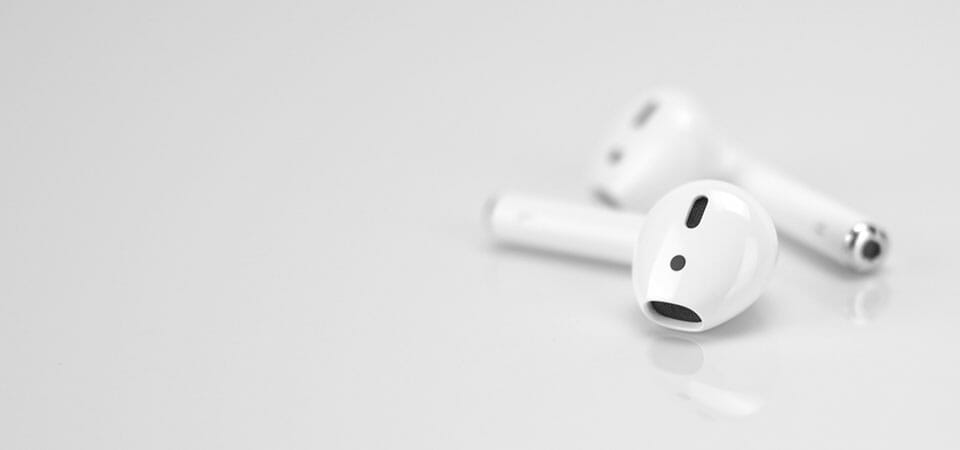
Earbuds (also called in-ear headphones, earphones, or in-ear monitors) are the smallest type of headphones. They fit inside the ear canal and take up little space. They’re portable and lightweight. Perfect for sports and on-the-go listening.
Earbuds prices range from super cheap, as low as $10, to expensive $1000+ custom in-ear monitors. Though average wireless earbuds go for $50-$200.
- The most portable headphone type
- Easy to pack and carry around
- In-ear earphones have great noise isolation
- High stability during activity and sports
- In-ears have better sound quality than classic earphones
- Can be uncomfortable with the wrong eartips
Earbuds are great for:
- Taking with you anywhere you go as you can put them in a pocket
- Working out and sports, earbuds stay in the ears and a resistant to water and dust
- Traveling conveniently with excellent portability
- Removing background noise with ANC earbuds
- Audio monitoring on stage
Don’t pick earbuds for:
- Home listening with the best sound quality because over-ears are better suited for the job
- Gaming at home, while gaming earbuds are decent, over-ear gaming headsets are better
Bone conduction headphones

Bone conduction headphones use bone conducting technology that keeps ears open while simultaneously sending music to your inner ears.
For this reason, it’s a popular choice for people who want to keep good awareness of their environment while listening to audio. Runners, cyclists, hikers and other activity-oriented people.
Most bone-conducting headphones have water protection and a great fit, but their sound quality is subpar.
- Perfect awareness to the environment because they leave ears open
- Super stable for activity and sports
- Most bone conducting headphones have high water protection
- Worse sound quality lacking clarity and bass
Bone conduction headphones are great for:
- Working out, sports and other activities where you want to keep listening to the environment
- Hard-of-hearing users who have difficulties hearing regular headphones
Don’t pick bone conduction headphones for:
- High sound quality because they lack clarity and bass compared to regular headphones
2. Sound Quality Factors
This is a quick explanation. Go here for details on sound quality in headphones.
These are all the sound quality factors you need to consider when buying new headphones:
Frequency response chart
A frequency response chart (graph) shows you how the headphones sound in terms of bass, midrange, and treble. The balance between the 3 frequencies creates distinct audio images, also called sound signatures.
We’ll explain it next…
Now, here are some examples of frequency response charts:
Bassy (emphasis on low frequencies)
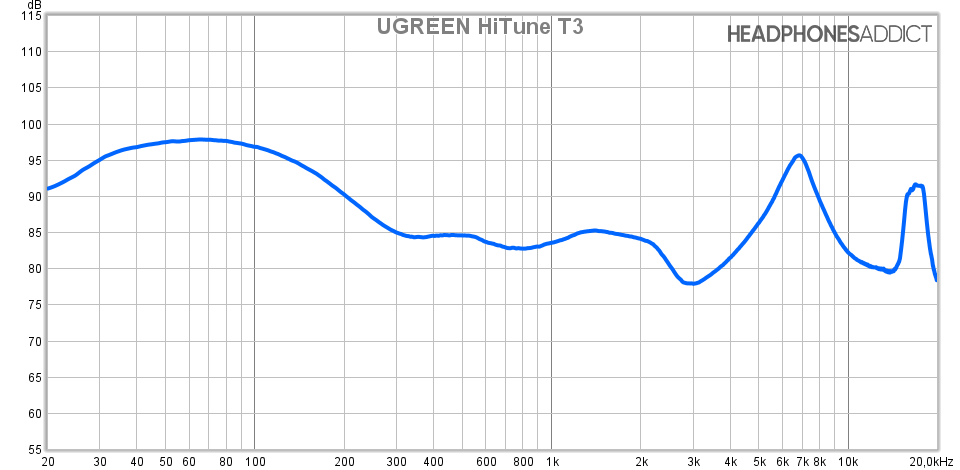
If you prefer powerful bass response, check the best bass headphones or best bass earbuds.
Balanced (all frequencies somewhat equal)

High treble (treble-emphasized freq. response)

Read more in-depth explanations of the frequency response here.
Now let’s continue to the next factor.
Sound signatures
A sound signature tells how headphones generally change the sound. Every pair of headphones slightly changes the sound.
Some boost bass, while others try to maintain perfect balance. We made recordings and explanations of each.
Check the different sound signatures and how they sound here.
Ask yourself: “Which one do I like the most?”
There is no correct answer.
This is entirely subjective.
Most headphones have one of the 3 sound signatures:
Balanced, flat: All ranges are equally represented. It’s great for all music genres.
Bass boosted, bassy: Boosted bass, low range is deeper and more powerful. It’s great for modern popular music.
V-shaped: Bass and treble are pronounced compared to mid-range. It makes music livelier and more energetic.
There is no objective standard for what sounds the best. Generally, neutral sound is considered better, but it’s not a rule. So, as long as headphones sound good to you, they’re a good choice.
Headphone impedance
Impedance is only relevant for wired headphones and earbuds.
If you’re buying wireless & Bluetooth headphones or earbuds, you can skip this section.

In wired headphones, impedance tells you how much electrical current the headphones resist. It’s measured in Ohms. The higher values resist a stronger current, and vice versa.
In practical terms, impedance over 32 Ohms (Ω) usually requires a stronger audio source: A good stereo system or an amplifier.
A regular smartphone, tablet, or laptop may not have enough power for the headphones to play music at a decent volume. They will sound quiet even at max volume.
To see the impedance, check the headphone specifications sheet. Look for the “Ohm” or “Ω” symbol.
In short:
- If you plan to use your new headphones with your phone and laptop, look for 32 Ohms or under.
- If headphones have a higher than 32 Ohm rating, expect to need an amplifier.
- Headphones in the 32-100 Ohm range might sound okay with a smartphone, but above that, an amp is necessary.
- Higher-impedance headphones don’t necessarily sound better.
Sensitivity
Headphone sensitivity and impedance are related but not the same.
Sensitivity is only relevant for wired headphones and earbuds. For factors relevant to wireless headphones, continue below.

In practical terms, sensitivity tells you how much power you need to play music at a decent volume. It’s measured in dB/mW or decibels (SPL – sound pressure level)/milliWatt.
- Higher sensitivity over 110 dB SPL/mW means you will get loud headphones with little power, like from a smartphone.
- A lower sensitivity, 90 dB SPL/mW, means a smartphone’s headphones will be quieter.
In this sense, it’s similar to impedance. And often, low-impedance headphones have higher sensitivity, so they’re easier to play loudly with a phone.
But it’s not always the case, so it pays to check.
Look for the sensitivity rating on the headphone specifications sheet.
Soundstage
Soundstage describes the feeling of space created by sound. It mimics the listening experience of being present at a live concert.
There is no way to objectively measure soundstage.
You only have to understand the difference between:
A big, wide and deep soundstage that recreates a life-like listening experience.
And narrow, tiny soundstage where all sounds originate from 1 central point. Usually in the middle of your head.
The bigger the soundstage, the more enjoyable it is to listen to.
General guidelines regarding soundstage:
- Over-ear headphones with big transducers recreate the best soundstage.
- Due to design limitations, earbuds (in-ear headphones) recreate the worst, smallest soundstage.
Learn more about soundstage in this article.
Headphone drivers (transducers)
The type and size of headphone drivers are a factor. Though somewhat smaller.
Many manufacturers reveal the number, type and size of drivers installed in headphones.

Driver type
Revealing the type of drivers generally satisfies the curiosity of customers and isn’t a big sound quality factor. Even expensive headphones with electrostatic drivers can sound bad.
Summary of driver types and their characteristics:
- Dynamic drivers
- Planar magnetic drivers
- Electrostatic drivers
- Balanced armature drivers
- Piezoelectric drivers
- Magnetostrictive (bone conducting) drivers
We go into detail about headphone drivers here.
Driver size
The size of the headphone driver gives a general idea of how powerful the headphones are. Headphones with bigger drivers (measured in mm – millimeters) are usually more powerful. But it’s a small correlation.
There’s one example where the driver size specification is useful. If you’re buying headphones with strong bass, a bigger driver size is better.
Number of drivers
Many earbuds (in-ear headphones) come with multiple drivers. But this is often just a marketing “feature” that doesn’t results in better sound quality.
Double or triple driver design might sound impressive on paper, but it’s no guarantee of better audio quality.
What’s the conclusion?
- There are many great-sounding in-ear headphones with multiple drivers that praise the fact.
- But there are also many bad-sounding in-ear headphones with multiple drivers that don’t benefit.
Noise cancellation impacts sound
Active noise cancellation (ANC) is a big audio factor.
ANC impacts sound quality, how much noise headphones remove from the background, and battery life.
These are the pros & cons to consider regarding ANC:
- It removes a lot more ambient noise, like traffic and cabin noise. This makes ANC headphones perfect for traveling, working and commuting.
- But it changes the audio quality by coloring the frequencies. Often, when you turn on ANC on cheaper headphones, it dramatically changes the music, taking away bass.
- ANC requires power which considerably lowers the battery life of headphones (especially earbuds). Battery life with ANC may be 25-30% lower.
Considering this, you have 2 choices:
- Either you prefer the effect of noise cancellation for more peaceful listening.
- Or you prefer a cleaner sound quality and longer battery life.
The higher the price you go, the smaller the difference. The best ANC headphones cancel a lot of noise with a long battery life and great sound quality.
Learn more about active noise cancellation in headphones.
3. Fit and Comfort
Comfort and stability of the fit is the second most important factor when buying headphones (according to this survey).
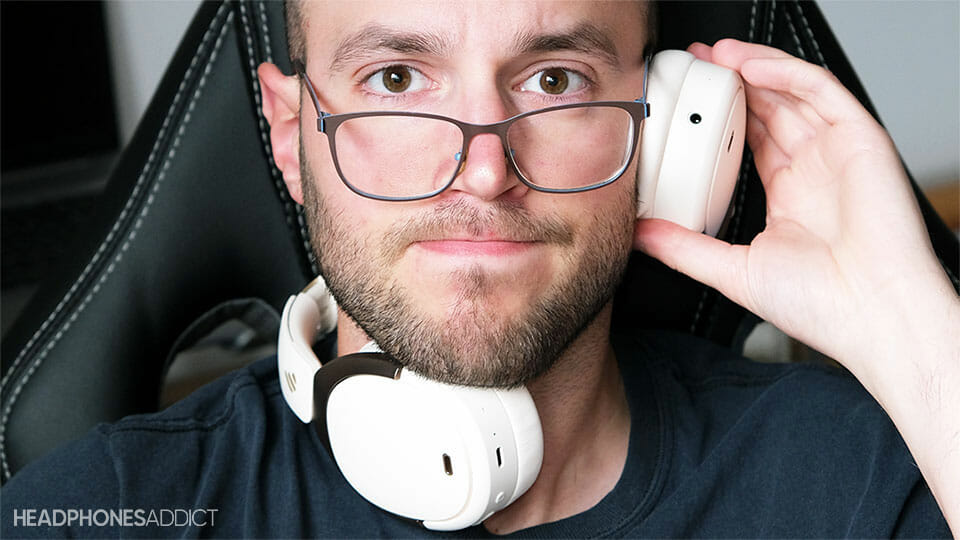
These are the comfort factors to consider:
Importance of stable fit
If you’re buying headphones for activity, the fit is crucial.
There are plenty of online topics about people struggling with headphones falling out (btw, here’s how to keep earbuds from falling out).
So, if you want to wear headphones during:
- Working out
- Running
- Sports
- Hiking
- Cycling
- Any other activity
You want workout earbuds with a proper fit.
Stay away from classical earphones like AirPods because they don’t stay in as well as in-ear earbuds.
Over-ear and on-ear headphones can work for low-movement activity as long as you know they induce sweating and fall down during hectic movement. Many people use them in gyms for lifting weights instead of earbuds.
Headband and earcup padding
Cushioning is crucial for good comfort.
Earpads are part of headphones in direct contact with your head. Look for thicker cushions and substantial padding on the headband.
Generally, this is not a problem. Most modern headphones are ergonomically designed and provide a comfortable wearing experience.
But look for “comfort red flags”:
- Thin headband padding
- Small earpads that squeeze ears
- Non-replaceable earpads, as eventually, you’ll want to replace them
Learn everything about headphone earpads.
Ear tips and in-ear fit options
You want many different eartip options, preferably memory-foam ones.
Note: This is relevant only for earbuds (in-ear headphones, in-ear monitors).
More different-sized and shaped ear tips ensure you’ll find a proper fit. Many higher-end earbuds come with an assembly of ear tips in the box.
We’ve written all about ear tip types and materials here.
Another thing to consider is the earbud-wearing style.
There are more ways to wear earbuds – in-ear headphones:
- Under-the-ear
- Behind-the-ear

Learn everything you have to know about how to wear earbuds here.
Adjustable features
Some headphones come with an adjustable design that improves comfort:
- The extendable headband makes headphones comfortable for people with big heads and relieves clamping pressure.
- Swiveling earcups adjust the angle to fit your head perfectly.
- Flexible headband material improves durability as well as comfort.
Everyone’s head and ears are a bit different. The features above help find the optimal fit.
Weight
Lightweight headphones are generally comfier.
This is a no-brainer. The less pressure headphones create on your head, the more comfortable they stay long term.
Find weight under headphone specifications. The lighter ones need less cushioning to dampen the pressure. Over-ear headphones are the heaviest, and earbuds are the lightest.
4. Wired vs. Wireless
How to choose between wired and wireless headphones?
Wireless headphones: Usually Bluetooth, a widespread and reliable wireless technology. You get to be free from wires but need to charge the battery.

Wired headphones: They don’t require charging and are often cheaper. But the cord gets in the way and takes away from convenience.
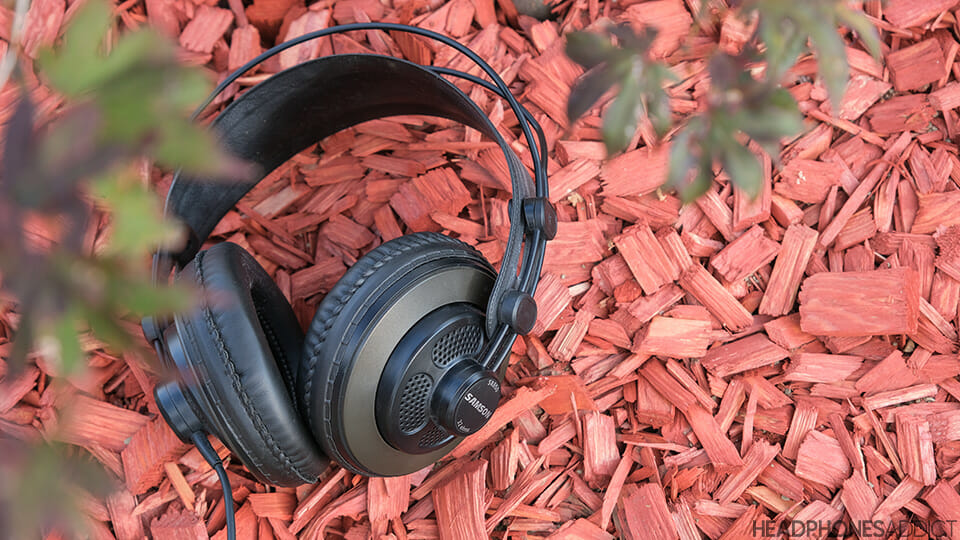
Here are the points to help you decide which type is better for you:
Pros & cons of wireless headphones:
- Better user experience without wires
- Require frequent charging
- Extra features with apps (if available)
- Shorter lifespan, technology gets outdated faster
Pros & cons of wired headphones:
- Tend to be cheaper
- Wires get in the way
- No need to charge, work all the time
- No app support or customization
- Evergreen technology that stays great for years
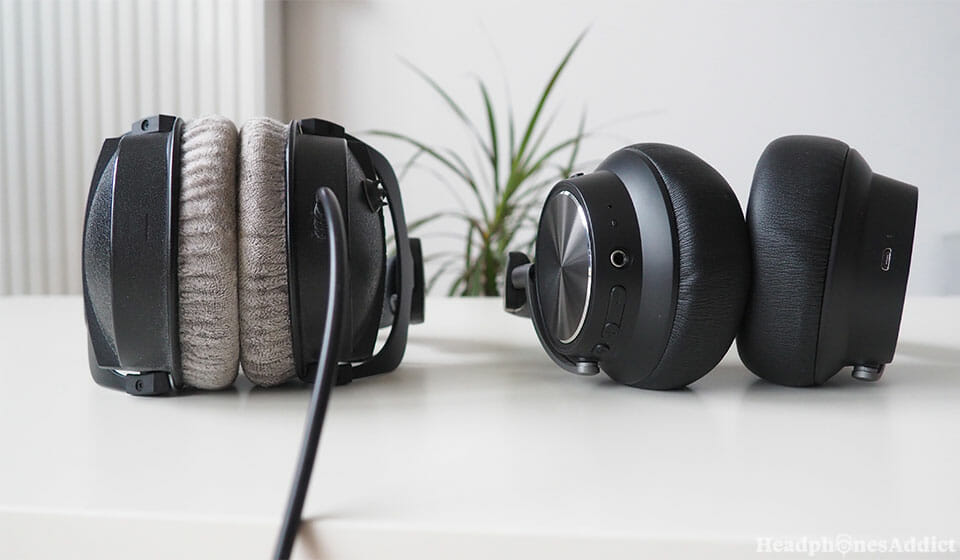
Other considerations before buying wireless headphones:
How important is the battery life?
Over-ear Bluetooth headphones can last for over 30 hours per charge. But true wireless earbuds last a lot less, even under 5 hours per charge, after some battery degradation. AirPods tend to lose battery quite fast.
How can you connect Bluetooth headphones?
You can connect Bluetooth headphones only to devices that support Bluetooth. And the device needs to support Bluetooth audio transmission. Most smartphones, tablets and laptops support it.
5. Additional Features for Specific Use
Here are other features to consider:
Do you need a quality microphone?
A microphone enables you to hold phone calls without taking the headphones off. Hands-free phone calls.
The quality of the built-in microphones is different on every model. We test it in every review and make a sample recording for comparison.
If you plan to hold phone calls with your headphones, get a model with clear voice quality.
Keep in mind the microphones built into headphones are generally okay for phone calls in normal conditions. But don’t expect to hold clear conversations in a loud environment, even with noise-cancelling microphone features.
Do you want controls and buttons?
Many headphones come with built-in buttons and touch controls for quick volume adjustment, song change, phone calls and other functions.
For example, if you like to change the songs and volume without touching your smartphone, they’re very convenient.
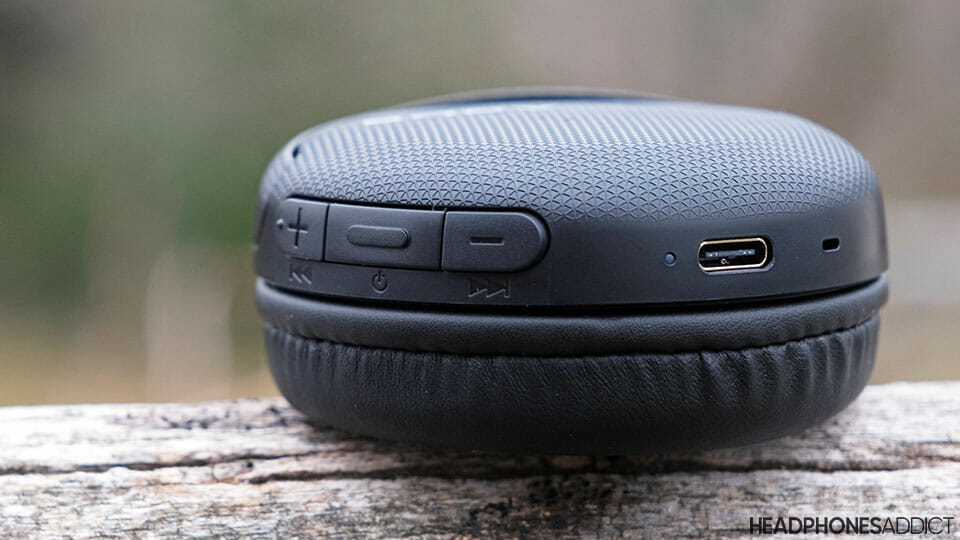
Controls are standard and part of most wireless headphones. But they’re different in the level of customization and user experience.
Some headphones have:
- Fixed controls where you can’t adjust them to your preference.
- A bad user experience where the touch controls are unresponsive, or you have to press them so hard it creates discomfort.
Read the reviews to find out how easy it is to use the controls. If you use your phone to listen to music and frequently get calls, this might be an essential feature for you.
Build quality and water protection
Headphones and earbuds are pretty durable. The main difference is in material quality and water protection.
- Look for sturdy materials like metal and quality plastics for headphones to last longer.
- In wired headphones, cables are often the weakest part. Replaceable cables are a big advantage.
Here’s how long headphones last on average.
Another thing to consider is water protection.
Water is the biggest enemy of electronics. Suppose you need headphones for working out or even just using outside in the rain. In that case, some level of water resistance is recommended.
Water protection is easily measured and rated in IP (ingress protection rating). It’s also known as IPX.
A higher IPX rating offers better protection against sweat and water. It goes from IPX1 to IPX9.
- For sweat-proof headphones, get at least IPX4.
- For waterproof headphones, get at least IPX7.
Thankfully, many modern workout headphones come with dependable protection from sweat and water.
Related:
Portability and travel-friendly features
Foldable headphones are more portable.
If you plan to take your headphones around the world, a foldable design is useful.
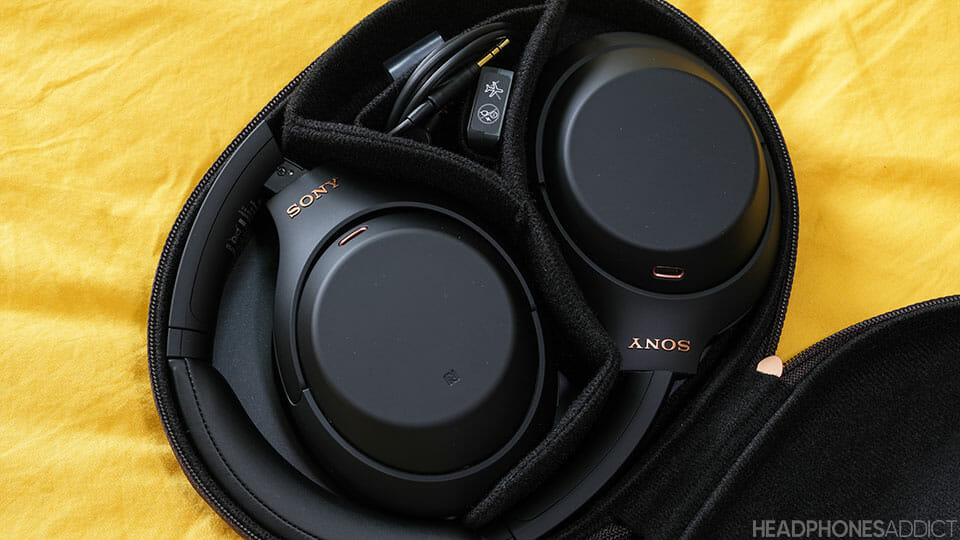
Taking non-foldable headphones on your travels is inconvenient.
- Over-ear headphones are big and clumsy. Plus, you can easily break them by accident.
- Earbuds are the most portable. Thanks to their small design, they’re easy to pack.
Price range and budget
How much are you willing to pay?
What are the general prices for headphones right now?

After testing hundreds of headphones and the best wireless earbuds around, these are the price ranges to expect.
Breakdown of headphone & earbud prices:
- Under $50 are considered cheap headphones
- $50 – $100 are affordable
- $100 – $300 are medium-tier (average)
- $300 -$500+ are high-end
- $500+ audiophile range
These are general price ranges. What is considered high-end also depends on the type of headphones. And earbuds tend to be a bit cheaper.
Noise cancelling headphones under $100 are cheap, but wireless earbuds for the same price would be mid-tier.
More expensive headphones are usually better and offer higher audio quality and better technology, but that doesn’t mean they’re the best choice for everybody.
In fact, we love finding great cheap headphones that offer a ton of value.
Here are some of the most popular price categories:
Active noise cancellation
Active noise cancelling headphones actively remove ambient noise. It’s useful for working, traveling, commuting and other situations with background noise.
There are differences in the effectiveness of ANC between headphones, but no easy way to measure it. We test ANC effectiveness in our tests (you can read in reviews).
The only way to determine how good ANC is by listening or checking ANC tests.
Here’s an example of an ANC test from a HeadphonesAddict review:
What to expect from active noise cancelling in headphones?
ANC is less effective at cancelling human voices or birds chirping. And much better at removing hums and constant noise.
Active noise-canceling headphones are popular with frequent travelers and commuters. Expect to pay a higher price for the technology.
ANC is widely used in headphones for traveling as well as everyday headphones. In fact, it originally became popular with pilots exposed to high-volume engine noise.
Limitations of ANC:
- It’s only effective for constant and lower-frequency sounds. It doesn’t cancel out sudden random noises. Also, it doesn’t remove conversation and high pitches.
- ANC headphones cost more money. Top consumer models range in the $300-$500 price range.
App support
Many Bluetooth headphones come with their own app. Inside the app, you can control many things like:
- EQ – equalization
- Customize controls
- Setup noise cancellation levels
- Geolocation, in case you lose them
- Ambient sound mode activation
- Custom sound profile creation
App support is very useful. Many times when you don’t like the sound out of the box, you can adjust it to your liking in the app without other equalization. Plus, it enables all the features headphones are capable of.
Heart-rate monitor & body tracking
While rare, some sports earbuds come with body tracking. It’s useful for sports people who want to measure their progress.
There are many other options to measure your heart rate, like with a smartwatch, smartphone, or a fitness band. If you don’t already have one of those, then earbuds with a heart-rate monitor are something to consider.
Special features
Many headphones and earbuds have proprietary features specific to their brand or model.
For example, Skullcandy Crusher headphones have a unique button that enables a special bass boost with vibrations. At full power, headphones vibrate to the tune of bass for a unique sensation.
While extra features aren’t the main thing to look for when buying headphones, it’s good to know they exist.
Quality Bluetooth codecs
Better-quality Bluetooth codecs are popular because they improve the wireless transmission of data thus, sound quality.
The common high-quality Bluetooth codecs are:
- AptX
- aptX HD
- aptX Low Latency
- LDAC
- LC3
And, while it’s true they improve the bitrate and send more data to your headphones, the sound quality difference is minimal. And not worth pursuing for an average user.
But if you’re hell-bent on getting the best wireless sound quality, then support for one of the better Bluetooth codecs makes sense.
Before you do that, test your hearing. Are you able to spot the difference? Find out if you can hear the difference in audio quality between compressed vs. original.
Closed-back vs. open-back
Most headphones have a closed-back design that offers better noise isolation and less sound leakage. It’s the standard and most suitable back design for most people.

- Closed-back headphones are much better at passive noise isolation. So, other people don’t bother you, and you don’t bother them with your music.
- Have a smaller, more intimate soundstage that originates from the middle of your head instead of around you.
But open-back or semi-open headphones let their drivers “breathe.” It improves the sound quality, especially soundstage. But it leaks a lot of music and has zero noise isolation.
- Open-back headphones leak a lot of sound and let in a lot of ambient noise.
- Open headphones sound better due to a bigger soundstage that improves the spatial cues (gives more of a life-like sound experience).
For these reasons, open headphones are usually preferred as headphones for home listening and by audiophiles.
Read more about the difference between closed-back vs. open-back headphones.
Researching and Comparing Headphones
Now that you know what type of headphones you want, you can start researching specific models and brands.

This is all straightforward but pays to repeat. Here’s how you find the perfect headphones for yourself:
Read customer reviews and ratings on websites and online stores: There is lots of information about a specific model from people who’ve already used the headphones you’re interested in. This gives you direct insight into what it’s like to use the headphones.
Try out and test headphones in stores: If you can visit a bigger store where you can test headphones in person, it’s a good idea.
Compare specifications and features: This is a no-brainer. But that’s how you make a decision. Rate each feature or spec according to how important it is for you. Then compare the score between models.
This way, you’ll have an objective way to make a decision.
Is it better to buy headphones online or in a store?

Online you can do better and faster research. In the store, the salesperson will usually try to sell you the headphones they get the best commission for (if commission based).
The selection of different headphones is also much better online since stores don’t have the space to stock all the products.
On the other hand, you often get hands-on experience in stores when they present test headphones. You can take them in your hand, listen to them and try their fit. Nonetheless, many headphones are stored in boxes, and you can’t try them without the salesperson.
Plus, you never know how many people have tried those headphones before you buy them. I like knowing my headphones are brand new, and I’m the first to wear them.
What about prices?
Generally, online prices are lower, but that’s not always the case. You can also find a good deal in a store if you’re shopping at the right time.
Consider shopping on special discount days and holidays. Black Friday and Cyber Monday sales are great examples.
Buying headphones online is convenient. You can do it from the comfort of your couch. You don’t need a laptop. You probably have a smartphone.
Choose from a wide selection of headphones, compare the prices from different stores, and get the best price. Going to a store is a hassle for many people, and it’s more expensive if you need to drive there.
How can you tell what headphones are wrong for you?
You get your new pair of headphones delivered to your home. You’re excited. You open the box and try them on.
They get uncomfortable really quick. While quality headphones provide great comfort for most people, they might not work for you personally. A pair of cans can get great reviews for comfort, but if they irritate your ears, return them and get another pair.
You don’t like the sound quality. All headphones sound different. Some are flat, some bass-heavy, and some in between. In any case, if you don’t like the sound of your new headphones and can’t get used to them, send them back. You’ll probably stop listening to them and just put them on some shelf forever.
You maxed out your credit card. Sure, expensive headphones are usually better, but that doesn’t mean you need to get an audiophile pair to be happy. You can get one of the best headphones under $100 that won’t be much worse than expensive models. $300 headphones aren’t 3 times better.
What Headphones to Get For…?
- Headphones for home listening
- Portable headphones for on-the-go use
- Headphones for working out and activity
- Gaming headsets
- Headphones for traveling and commuting
- Versatile headphones, all-rounders
Here’s what to look for in…
Headphones for home listening

Big over-ear headphones with wires are perfect for home listening. They enable you to relax on a couch while listening or watching TV. The convenience of the wireless isn’t that amazing.
- Maximize sound quality and comfort.
- You can choose from closed-back and open-back designs. The difference is that open-backs leak more sound but have a better soundstage, which means better audio quality.
Portable headphones for on-the-go use

Smaller on-ear and in-ear headphones (earbuds): They’re small and the easiest to pack for the road.
In on-ear headphones, look for a foldable design, as they are easier to store and take with you.
- ANC earbuds effectively remove background noise which is great for portable use.
Headphones for working out and activity
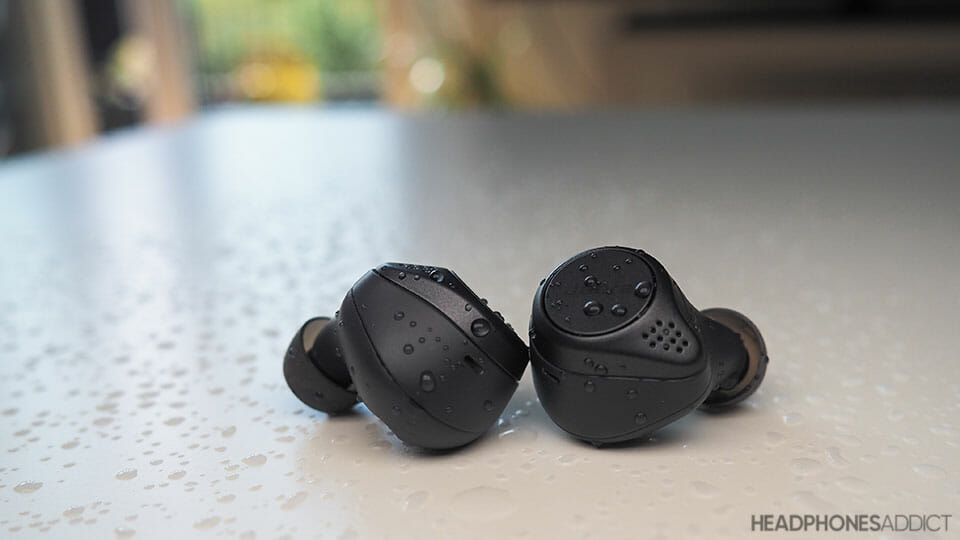
Headphones for working out and running have a couple of requirements:
- Need at least some water resistance (min. IPX4 or higher)
- Need to stay put during movement, so you can focus on the activity
Earbuds (in-ear headphones) are by far the best type, with on-ear headphones coming second.
Look for earbuds with ear wings, hooks, and eartips for extra stability.
Gaming headsets
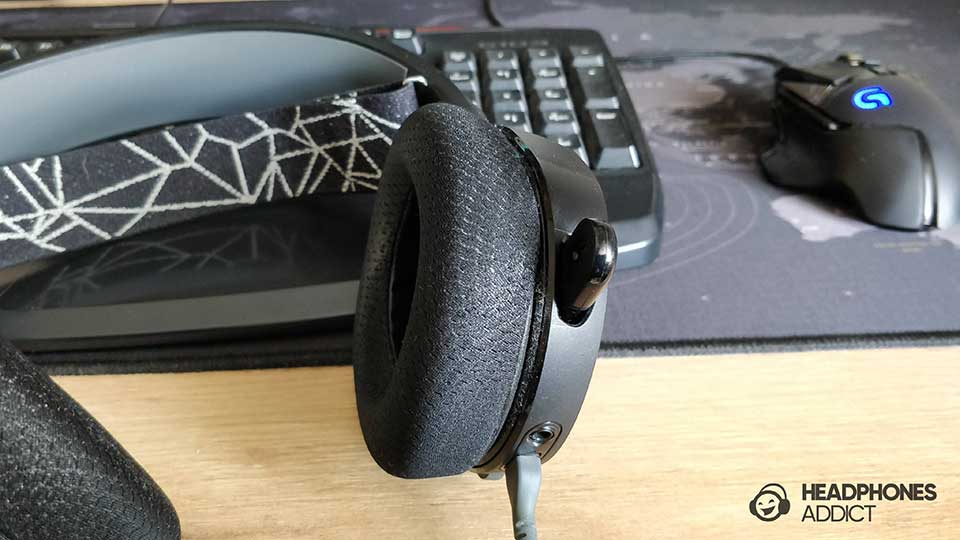
A quality gaming headset needs:
- To be super comfortable (big earcups), breathable material, lightweight
- Over-ear earcups with a closed-back design to remove distractions and sound leakage that could get picked up by the mic
- Have replaceable earpads because they will get worn out. This also prolongs their life
- A reliable and clear microphone for multiplayer games and chatting with friends, a boom microphone with a mute button is a must.
- Big soundstage to hear the footsteps of your enemies before you see them.
Find the best PlayStation headsets .
As an alternative, you can combine a pair of regular headphones with an add-on microphone like the ModMic Wireless.
Headphones for traveling and commuting

Comfortable over-ear headphones and earbuds with ANC are the best for traveling
- Look for ample cushioning and a lightweight design to ensure comfort
- ANC (active noise cancellation) removes background noise, so you can focus on your music
With good traveling headphones, you’ll cancel out a lot of annoying background noise and enjoy your music in peace. These are the go-to headphones for frequent fliers and commuters.
Versatile headphones, all-rounders

Versatile headphones do a little bit of everything. You can use them at home, take them with you as portable headphones and even take them to the gym.
They might not be the best at anything, but they are decent for many things. This way, you only need one pair of headphones.
Look for:
- Wireless Bluetooth connectivity, so you can connect them to many different devices.
- The type of headphones isn’t that important. Choose according to your preference.
- Choose features like sweat resistance for gym workouts or ANC for flying.
You can pick any model for this job as long as they have the features you want.
Should you buy used headphones from eBay or other secondhand sites?
You can definitely buy secondhand if you’re okay with having used headphones. You can save considerable money.
But you have to be sure that the fact other people have worn your headphones doesn’t bother you.
Plus, if you get wireless headphones, you should know that battery life diminishes with age. The older the headphones, the worse the battery capacity.
Also, they might have visible signs of wear, skin grease, and an uncomfortable smell. It’s possible to reject those headphones but make sure that’s a policy on the secondhand site you’re using.
FAQs
What should you consider when buying headphones?
When buying headphones, you should consider the type of headphones, price range, what you intend to use them for, and features that you need, like active noise cancellation, water protection, quality microphone, etc.
What is the difference between cheap and expensive headset?
The difference between cheap and expensive headsets is in the quality of materials, brand recognition, sound quality and software features. But expensive headsets don’t necessarily have better audio quality or better features. It depends on the model.
What should I look for in Bluetooth headphones?
In Bluetooth headphones, you should look at battery life, the stability of their wireless connection and the same as in headphones in general: sound quality, comfort, durability and extra features.
Conclusion
Now you should know how to buy the perfect headphones and earbuds like a pro. I’ve covered all aspects I could think of in this headphone buying guide.
It’s essential to understand the differences between types of headphones and what features you need and want.
If you have more questions, please let me know in the comments below.
Now, remember what you learned here and go shopping for headphones. 😊

Matija Ferjan is a seasoned audio enthusiast reviewing headphones since 2015. He has personally tested hundreds of headphones and earbuds. He’s an active member of the Headphone Audio community and a true nitpicker, always looking for the “best-value-for-money” headphones.


